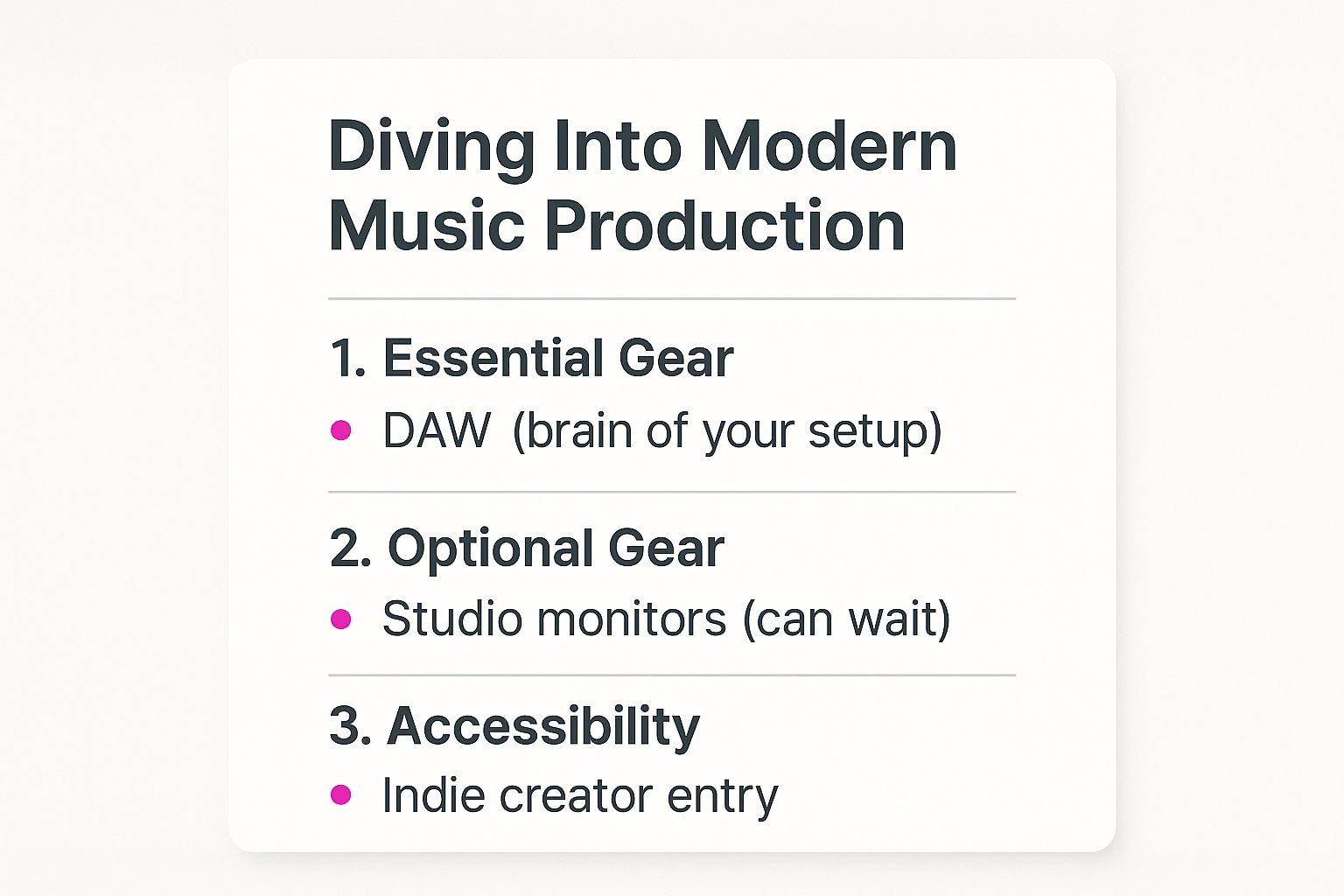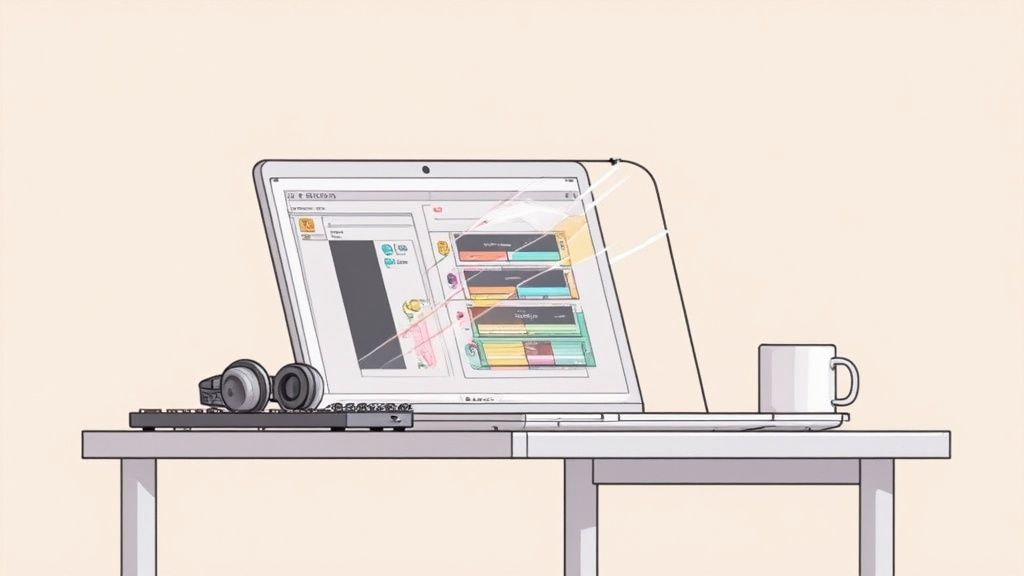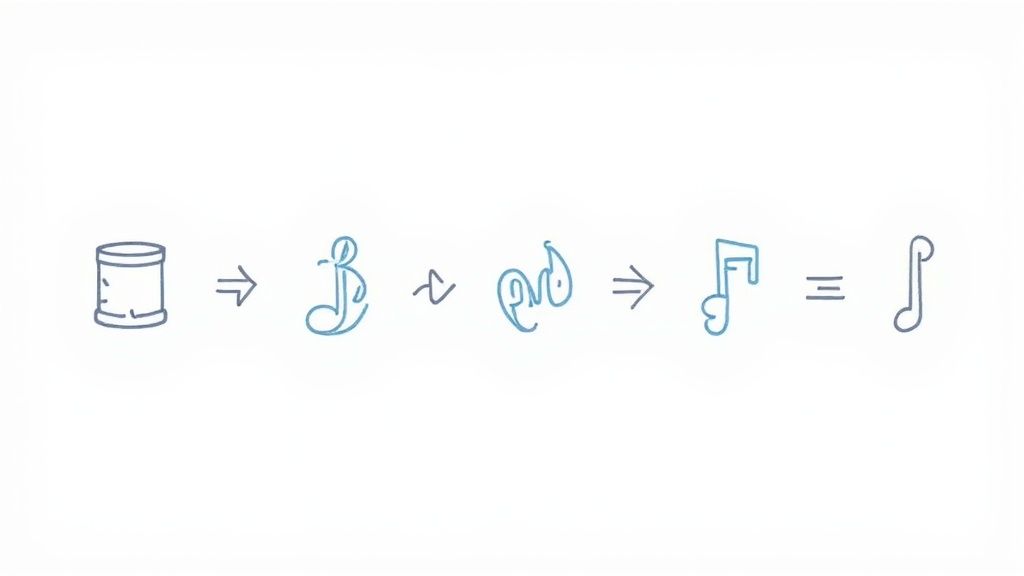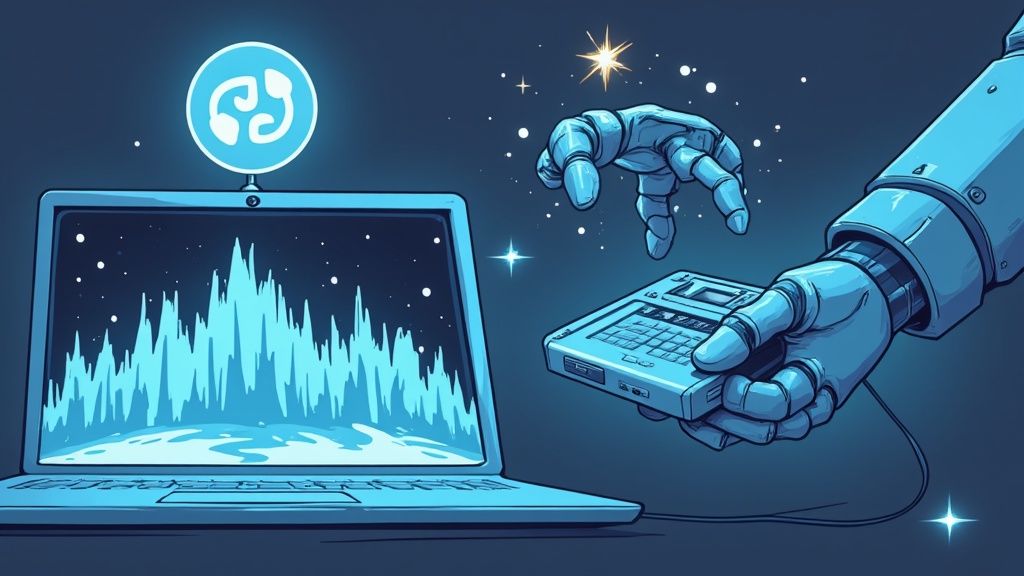Getting into music production might seem like a huge mountain to climb, but it’s honestly simpler than you think. You don't need a million-dollar studio packed with blinking lights and intimidating hardware anymore. These days, everything revolves around your computer and one key piece of software.
The whole game has changed for independent creators. We're in the middle of a massive boom in the global recorded music industry, which hit $29.6 billion in 2024, mostly thanks to streaming. In the US alone, streaming was responsible for a staggering 84% of all recording revenue in 2023. This digital-first world means producers can cook up professional-sounding tracks in their bedrooms and get them out to the entire world. If you're curious, you can learn more about the future of music production and its trends.
Forget the myth that you need to be a technical wizard or a classically trained pianist. Modern music production is all about creativity and finding a workflow that clicks for you. Your most valuable tool isn't some rare vintage synth; it's your Digital Audio Workstation, or DAW. This software is the command center for your entire operation—it's where you'll record, arrange, mix, and finalize all your music.
The key is not to wait for inspiration. It's to get into it, start doing something, and then the inspiration will come and find you. Most people have it backward; they think you need inspiration to take action, but you have to take action first.
This infographic really nails the essential starting points.

As you can see, the DAW is non-negotiable. But that expensive gear, like professional studio monitors? That can totally wait. It really drives home how accessible this all is for newcomers.
It’s way too easy to get sucked into a YouTube rabbit hole of gear recommendations. Let’s cut through the noise. Here’s a quick and dirty breakdown of what you actually need right now versus what you can put on your wish list for later.
By sticking to the essentials, you'll avoid dropping a bunch of cash and feeling paralyzed by having too many toys. The goal is to start making music now. Get that momentum going and build your confidence from there.

Let's kill a myth right now: you absolutely do not need a world-class, multi-thousand-dollar studio to make incredible music. That idea is what stops way too many talented people before they even lay down a single note.
Our goal here is simple. We're going to build a lean, effective home setup that gets you creating as quickly as possible without draining your bank account. To get started, you really only need four things: a computer that can handle the job, your DAW, a good pair of headphones, and a basic MIDI keyboard. That’s it.
Your computer is the heart of the operation. It's non-negotiable. It doesn’t have to be a top-of-the-line beast, but it needs enough juice to run your DAW without choking. A good baseline to aim for is at least 8GB of RAM. Honestly, the laptop or desktop you already own is probably powerful enough.
Next up, how you listen. It's tempting to drop a ton of cash on those cool-looking studio monitors, but for a beginner, that's a mistake. Why? Your room. An untreated bedroom or office has terrible acoustics that will completely lie to you about what your mix actually sounds like.
Focus on the gear that gives you the most immediate creative power, not what looks impressive. A simple, functional setup you actually use is infinitely better than an expensive one collecting dust.
This is where a solid pair of headphones becomes your secret weapon. They take your room's funky acoustics completely out of the equation. You get a clear, detailed picture of your sound, which is absolutely critical when you start mixing.
Diving into gear can feel overwhelming, so I've put together a simple breakdown of the essentials. Think of this as your roadmap to a powerful starter studio, with some specific, battle-tested recommendations that give you the best bang for your buck.
Here’s a quick overview of what you’ll need to get rolling.
This list covers the core components that will have the biggest impact on your workflow from day one.
Headphones: Grab a pair of closed-back studio headphones. Models like the Audio-Technica ATH-M20x or the Sennheiser HD 280 Pro are industry workhorses for a reason. They give you great sound isolation so you can zero in on the details.
MIDI Keyboard: A small 25-key controller like the Akai MPK Mini is perfect. You're not trying to learn a piano concerto; you just need a quick way to get melodies and chords from your head into your project. It's a massive workflow booster.
Audio Interface (Optional, but a smart next step): While you can start without one, an interface like the Focusrite Scarlett Solo is a game-changing upgrade. It delivers way better sound quality than your computer's headphone jack and gives you a proper input for plugging in a mic or guitar later. If you plan on singing, our guide on the best microphones for home recording vocals can help you find a perfect match for an interface.
By focusing on these key pieces, you're building a solid foundation. You'll learn the ropes on reliable gear, making your first steps in production creative and fun, not frustrating and expensive.
Your Digital Audio Workstation (DAW) is the brain of your entire operation. It's the software where you’ll record, arrange, mix, and ultimately finish every single track you make. Think of it as your virtual studio—the canvas and toolbox all rolled into one.
The sheer number of options out there can feel paralyzing when you're just learning how to start producing music. But instead of getting lost in endless feature lists, let's focus on what actually matters for a beginner: workflow and feel.
Your main goal is to find a DAW that feels intuitive to you. It should get out of your way and let your creativity flow, not block it.
For most people starting out, the choice boils down to three major players: Ableton Live, FL Studio, and Logic Pro. Each one is more than capable of producing professional, radio-ready music, but they all approach the creative process in fundamentally different ways. The "best" one is simply the one that clicks with how your brain works.
FL Studio: Famous for its incredibly fast, pattern-based workflow. If you're all about making beats for hip-hop or electronic music, its step sequencer and piano roll are legendary for getting ideas down in seconds. A lot of producers love how visual it is for building out loops.
Ableton Live: This one was built from the ground up for both studio production and live performance. Its unique "Session View" lets you experiment with loops and ideas in a non-linear way, making it a beast for brainstorming and arranging on the fly. It's a massive favorite in electronic music circles for this flexibility.
Logic Pro: A powerhouse that's available exclusively for Mac users. It comes absolutely loaded with a massive library of high-quality stock sounds, virtual instruments, and effects, which gives you incredible value right out of the box. Its traditional, linear layout will feel pretty familiar if you've ever used other editing software.
If you're just getting started and cost is a concern, don't sweat it. Most DAWs offer free trial versions or lite editions so you can get your feet wet without spending a dime. For a deeper dive, check out this guide on the best free Digital Audio Workstation software to find an option that fits your budget.
No matter which software you land on, you'll run into the same fundamental building blocks. Getting a handle on these core elements will make you feel at home in any production environment.
The screenshot below shows off FL Studio’s interface, highlighting its famous Channel Rack and Playlist view.
See how patterns are built in the Channel Rack on the left and then arranged into a full song on the timeline to the right? This visual separation of loop creation and song arrangement is exactly what makes its workflow so addictive for beatmakers.
Key Takeaway: Don't overthink your initial DAW choice. Seriously. Download free trials for two of them and spend a few hours trying to make a simple beat. The one that feels less like a chore and more like a playground is the right one for you, right now. You can always switch later on.

So, you've got your gear hooked up, your DAW is open, and you’re staring at… nothing. The infamous blank screen. This is the spot where a ton of new producers freeze up.
The trick is to stop trying to create a masterpiece right out of the gate. Seriously. Just focus on building one small piece at a time. The real secret here isn't some divine spark of creativity; it's just having a solid workflow you can fall back on every single time.
A layered approach is probably the most reliable way to beat that initial anxiety. You start with the rhythm and just build up from there, giving yourself a solid grid to work on.
In most modern music, the drums are the absolute heartbeat of the track. Getting a solid groove going gives you the energy and the entire context for everything else you're about to add.
Don't go crazy here. A simple four-on-the-floor kick pattern is perfect for house or techno. For hip-hop, you can't go wrong with a classic kick-snare combo.
Here’s a quick way to build your first loop:
That’s it. You’ve got your rhythmic foundation. Now just loop that for 8 or 16 bars, and you have a canvas to start painting on.
With your drums on a loop, it's time for the bass. The bassline and the drums are best friends—they work together to lock down the core groove and the harmonic base of your track.
It doesn't need to be fancy. A great starting point is to just have the bass play a note every single time the kick drum hits. This creates this powerful, unified low-end that makes your whole track feel grounded.
Find a simple bass patch in your DAW and try tapping out the root notes of a simple chord progression. Keep it simple and focus on the rhythm.
Alright, now for the fun part: the melody. This is the piece that gets stuck in someone's head. Since your bassline has already sketched out the harmonic structure, you have a pretty good guide for what notes are going to sound good.
Inspiration follows action. Most people think you need inspiration to take action, but you have to take action first. Get into it, start doing something, and then the inspiration will find you.
Don't stress about writing the perfect melody right away. Just hum ideas over your loop, mess around with a simple synth or piano sound, and make sure you hit record. You never know when a great idea will pop out. Even a simple four-note pattern can be incredibly catchy if the rhythm is right.
With your core elements—drums, bass, and melody—in place, you can start adding depth. This is where chords and other sonic textures come in.
Grab a pad or an electric piano sound and lay down some simple chords that support the melody you wrote. These elements add the emotional weight and fill up the space in your track, making it sound full and complete.
This whole process—drums, then bass, then melody, then chords—is a reliable roadmap. It takes the overwhelming task of "making a song" and breaks it down into a series of small, totally manageable steps. Stick with this workflow, and you'll find yourself turning simple ideas into finished beats consistently.

Today’s producers have an arsenal of tech that can feel like a superpower. The real trick is learning how to treat modern tools, especially AI, like a creative partner—something that boosts your workflow, not a crutch that replaces your unique ideas.
Think of AI as your tireless assistant. When you’re staring at a blank project, stuck on where to begin, an AI tool can spit out a few chord progressions to get the ball rolling. Struggling with a melody? It can generate a handful of ideas to spark your own creativity. This isn't cheating; it's just working smarter to stay in the zone.
AI is genuinely changing how beginners learn the ropes. In 2025, tools like Suno AI and LANDR are hitting the mainstream, letting you master a track or generate ideas from a simple text prompt. These were tasks that used to take years to get good at.
It's no surprise the music production software market is set to hit $6.99 billion in 2025, an 8.9% jump in just one year. That tells you everything you need to know about the demand for these kinds of accessible tools.
Beyond AI, your DAW's real power gets unlocked with plugins—small software add-ons that act as virtual instruments or effects. You'll often hear them called VSTs (Virtual Studio Technology). While you can spend thousands, the free plugin scene is absolutely incredible for anyone starting out.
Here are a few free plugins every new producer should grab immediately:
With just these three, you can take a simple idea and make it sound shockingly professional without spending a dime.
The goal isn't to let the tools do all the work. It's about using them to smash through creative blocks, speed up the boring stuff, and explore sonic possibilities you never would've found on your own.
If you want to dig deeper into how AI is helping all kinds of artists, check out these resources on general use cases of AI for Creators. Embracing these tools will fast-track your journey as you learn how to produce music, turning frustrating hurdles into exciting new directions.
You’ve done it. You’ve wrestled with melodies, drums, and basslines and finally have a finished track. That’s a huge win. But now comes the really exciting part: getting your music out of your studio and into the ears of listeners all over the world.
This last leg of the journey involves mixing, mastering, and distribution. It sounds technical, I know, but it’s more accessible today than it’s ever been.
First up is mixing. This is where you take all the individual instrument and vocal tracks and get them to play nicely together. Think of it like conducting an orchestra. You're adjusting the volume with faders, placing sounds left or right with panning to create a wide stereo image, and using EQ to carve out space for each element. The goal is to make sure the kick drum hits hard without drowning out the melody, and the vocals sit right on top of the beat, clear and present.
Once your mix is sounding tight, it's time for mastering. This is the final coat of polish that makes your song sound professional, loud, and consistent across different speakers—from tiny earbuds to massive car systems. While you can hire a professional mastering engineer, there are some incredible tools out there for beginners. Automated services and plugins like iZotope Ozone Elements are designed to give your track that competitive sheen without a steep learning curve.
With your mastered track ready, the next step is getting it onto platforms like Spotify and Apple Music. This is where you get to tap into the massive power of streaming. In the US alone, streaming pulled in a record $17.1 billion in 2023, which is a staggering 84% of all music industry revenue. That means your potential audience is global and just a click away. For a deeper dive, you can explore the full US music market overview on Soundcharts.
So, how do you actually upload your music? You’ll use a digital distributor.
Key Insight: Think of a distributor as the middleman between you and the streaming platforms. You give them your mastered audio file, artwork, and info, and they handle the technical stuff, making sure your track gets delivered to every major digital store.
Services like DistroKid or TuneCore have made this process incredibly straightforward. You upload your files, fill out a form, and they push your music out to hundreds of platforms. It’s a vital step, and choosing the right music distribution service can make a huge difference in how effectively you reach people.
This direct-to-platform model has completely flipped the script for new producers learning the ropes. You no longer need a record label to get heard. To see what this looks like in the real world, check out our case study on how Lilo Key gets 90,000 monthly listeners on Spotify. The path from your bedroom studio to a global stage has never been this clear.
Ready to make sure your music sounds amazing everywhere, especially in the car? CarMaster offers AI-powered mastering specifically designed to protect your sound on automotive systems while ensuring it translates perfectly to speakers and headphones. Get a free, instant preview and release your music with confidence. Master your track at https://www.carmaster.io.